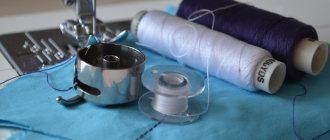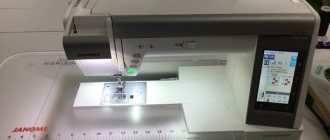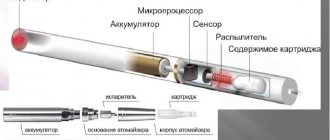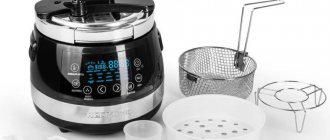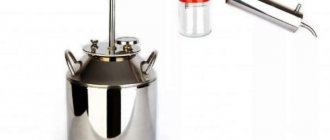Working on a sewing machine begins with threading the upper and lower threads. If there is the slightest inaccuracy in carrying out such a procedure, it will never be possible to achieve an even and beautiful stitch. The machine will either not sew at all, or it will tear the thread and form a seam with gaps and loops protruding above the fabric.
We will talk about the importance of choosing the right bobbin, how to wind thread on it, and what nuances you should pay attention to when threading. From our article you will also learn about what defects and malfunctions in the operation of the machine can arise due to incorrect installation of the bobbin, and how to eliminate them.
Purpose of bobbins and their types
The bobbin is a small spool for winding the lower thread. The bobbin is inserted into a bobbin case, which is placed in a shuttle device located under the needle.
When sewing fabrics, a seam is formed by weaving the top and bottom threads through the material. The upper thread is threaded into the needle, which, when lowered down, plunges into the bobbin case, capturing the lower thread. The bobbin is needed to smoothly feed the lower thread and ensure its normal tension when sewing.
The state of the line is affected by:
- Thread quality and thickness;
- Correctly threading the upper and lower threads, as well as fixing the bobbin case in the hook;
- Accuracy of thread tension adjustment.
Expert opinion
Irina Vasilyeva
Designs clothes, teaches at her own school and advises beginning seamstresses
It is desirable that the thickness of the lower thread be one number less than the upper one. This will allow you to get a neater seam and reduce the likelihood of the top thread breaking while sewing fabrics. If strong standard threads are used, their thickness can be the same.
Threading the double needle
The double needle in the device can be indispensable when the product needs to be decorated with a double stitch (straight or zigzag).
To refill you will need another coil. They both should be the same. In a manual or foot-operated sewing machine, there are two spool holders located on the body. Next, both ends pass together through the hole in the thread take-up.
Twin needles
A double needle is installed based on the same requirements as a regular one. The groove on the needles, along which the upper thread should slide, must be positioned correctly.
Work order:
- A double needle is installed. Fixed.
- Both spools are placed on the body of the sewing machine and the threads are passed together in the same way as only one was supposed to be threaded.
- The lower thread guides, located directly next to the needle, should separate them into two.
- Each of them is threaded into a corresponding needle and pulled back under the paw.
Important! Make sure that the presser foot installed is designed for use with a twin needle.
Correct installation
When sewing things with a double needle it is not much different from the usual one. The work uses two upper threads and one lower thread. For better stitching, the tension needs to be slightly loosened.
You can read about the reasons for thread tangling in sewing machines at the link.
Numbers of threads and sewing needles for various materials
| Material type | Needle numbers | Thread numbers |
| Cotton / Silk | ||
| Batiste, silk | 70 | 80/65 |
| Satin, chintz, calico | 80 | 80/65 |
| Calico, flannel, thick silk, heavy cotton or wool fabric | 90 | 50-60/ — |
| Teak, suit wool | 100 | 40/ — |
| Cloth, drape | 110-120 | 30/ — |
Sewing machines are equipped with special devices for quickly and evenly winding thread onto the bobbin. When hand-winding, the thread tension is weaker, so the quality of the stitching is worse.
Machines of various models are equipped with shuttle mechanisms and bobbin cases of several modifications. Accordingly, bobbins of different heights and shapes are used.
For industrial sewing machines, narrow metal bobbins are used, and for household machines, wider ones are used.
The advantages of metal bobbins are strength and durability. They do not form nicks that interfere with the free movement of the thread.
The advantage of plastic bobbins is the ease of sliding along the walls of the bobbin case. It is possible to monitor the thread consumption through the transparent plastic base. When sewing on machines with a horizontal shuttle, such control plays an important role.
The disadvantages of plastic bobbins include low strength. A fast-moving needle can easily scratch the surface of the bobbin and leave nicks on it, which can cause the thread to break and become tangled in the hook.
Important! Bobbins vary in size for different machines, so these products are not universal.
Locations for measuring bobbin sizes for various machines (see table below)
General procedure
In order for the stitching to be beautiful and durable, it is important to observe one of the main conditions for effective work: the lower and upper threads must be of the same thickness and quality.
General guidelines for the order in which to thread the sewing machine:
- When starting to sew a textile item, you need to wind a little thread from the selected spool onto a bobbin.
- Top threading. Since each machine model has its own characteristics, it is advisable to act according to the attached schematic instructional material.
- Threading the lower thread. To perform this stage, the bobbin is placed in a special bobbin case.
- A bobbin case, with a bobbin inside, in the part of the mechanism intended for this purpose.
Refueling scheme - Through the plate, along which the fabric moves while stitching, the bottom thread is brought to the surface.
- The ends of both threads are under the foot.
Important! The quality of the completed filling can be checked. To do this, rotate the flywheel so that the needle goes down and rises again. With one revolution of the shaft you should get a loop.
Bobbin sizes for some sewing machines
| Bobbin dimensions, mm | ||||
| Measurement location | "Kharkiv" | "Tula" | "Gull" | "Podolsk" |
| 1 | 9.3 | 8.8 | 12 | 12 |
| 2 | 8.4 | 8.0 | 11.5 | 11.5 |
| 3 | 6.6 | 7.7 | 10 | 10 |
| 4 | 21.3 | 19.7 | 20.4 | 20.4 |
| 5 | 9.0 | 10 | 9.5 | 9.5 8.5 6.2 |
| 6 | 8.7 | 7.5 | 8.5 | 8.5 |
| 7 | 6.2 | 6.1 | 6.2 | 6.2 |
The bobbin is inserted into the bobbin case
The bobbin case is the most important part of the sewing machine, which should always be in perfect condition. The surface of the bobbin case should be mirror-like, at least clean, without rusty or oxidized areas. The slightest notch on the surface of the bobbin case or a chip in the wall will lead to the appearance of many stitch defects, ranging from looping stitches and skipped stitches to thread breakage.
Please note that bobbin cases do not always have a “tail”. In addition, when purchasing a new cap, keep in mind that this tail may be turned in the other direction.
How to choose the right bobbin
When choosing a bobbin, it is important to remember that:
- It must fit the hook of the sewing machine you are using;
- There should be no nicks, scratches or chips on it. The ideal option is a bobbin with a smooth glossy surface;
- The reel must have a normal shape, otherwise it will get stuck in the shuttle.
A good bobbin fits easily into the bobbin case. If you install it in the shuttle device and then slowly pull the thread, it will come out smoothly, without jerking.
If you use a spool that has defects and clings to the walls of the cap, loops will appear in the stitching due to a violation of the tension of the lower thread. Possible permanent damage to the bobbin and jamming of the mechanism.
When choosing a new bobbin, it is advisable to have a proven sample with you. This also applies to the bobbin case.
For home sewing, you can purchase plastic bobbins. They are cheaper, and having a whole set of such spools with threads of different colors and thicknesses, you can save time on preparing the machine for work. For professional sewing, it is better to buy more durable metal bobbins.
Instructions
If everything is done correctly and according to the instructions, then the machine is ready for use. Let's look at this process step by step:
- You need to place the bobbin in the cap and thread the tip of the thread into the notch on the cap. Therefore, before inserting the bobbin, you should unwind a few centimeters.
- During threading, the bobbin case is held so that the hook from the lock lies on the person’s thumb.
- The part is put in place and the free end of the thread is pulled into the groove of the cap. It should fit into the spring terminal and exit through a special recess in the thread guide.
- Then grab the cap by the seal and place it in the machine. When it is in place, the latch can be released. It should sit tightly in the device and not turn.
- Next, you should turn the flywheel towards you so that the needle makes a couple of moves it is accustomed to. As a result, the upper and lower threads should connect and the output will be a large loop.
- The resulting loop is untied, the upper and lower threads are pulled out (about 15 cm) and guided behind the foot.
Next you should check the thread tension. Modern devices have special thread tension regulators. In general, the threading process may vary from device to device. In most cases, there are detailed diagrams and descriptions of refueling. In addition, the elements are arranged in such a way that it is easy to guess the meaning of further actions. Certain difficulties arise more often with manual control mechanisms.
REFERENCE! The threads in the bobbin case should rotate strictly clockwise.
When you first get acquainted with the machine, threading may seem difficult and tedious. However, after repeating this action a couple of times, in the future it can be done very quickly, without even thinking about the sequence.
Winding thread onto a bobbin
Modern sewing machines are equipped with a device for winding thread onto a bobbin. It is located at the top of the body. Only the holder for placing the bobbin and the fixing device are brought out.
Winding is done in the following order:
- A spool of thread of the required size is placed on a rod located in the upper part of the body. In this case, the thread should leave it counterclockwise;
- The thread from the spool is pulled through a tension device located next to the rod. Then it is brought to the bobbin, threaded through a hole on one of its bases and wound around the leg several times to secure it;
- The bobbin is put on the holder so that the spring located in its upper part fits into the groove on the inner surface of the bobbin. When you press it, you should hear a click. It is important to direct the thread so that it winds clockwise;
- The holder together with the bobbin moves towards the latch to the limit (a click is heard again);
- In order for the needle to remain motionless while winding the lower thread, the rotation mechanism of the working shaft is turned off. Various types of machines provide for stopping the flywheel by pulling or loosening the screw that holds it;
- The machine is connected to the network, and the winding device is operated using a foot pedal. Once the bobbin is full, the latch moves away from it and winding stops. Approximately 40 m of thread is wound onto the bobbin;
- The working position of the flywheel is restored.
How to thread the upper thread
6. Turn the handwheel until the thread take-up (4) rises to its highest point.
I pass the thread according to the diagram - first through the needle threader (1), thread guide (2). Then I pass the thread in a zigzag around thread guides 3 and 4, while tucking the thread into the eye of thread guide 4.
7. I pull the thread down and pass it through the thread guide (5), then through the needle thread guide (6) and the last step is to thread the thread through the eye of the needle.
ADVICE. In order for the thread to quickly pass into the eye of the needle, you need to cut the tip of the thread with scissors at an angle.
Threading and adjusting thread tension
To thread the upper thread, the spool is placed on the holder rod so that it unwinds clockwise. Pass the thread through the holes of the guide and the disk tension regulator, pass it through the retaining hooks and bring it through the second thread guide to the needle. The length of the free tail is approximately 12 cm.
Threading the bobbin thread in machines with a vertical shuttle
The vertical shuttle is installed in such machine models as
Chaika 143A
Veritas 8014-35
Jaguar EL 223
When threading the lower thread, perform the following steps:
- Remove the shuttle cover. Hold the bobbin case in your hand and insert the bobbin into it. Pass the thread under the spring and insert it into the slot at its end;
- Insert the threaded bobbin case into the hook device by pulling the latch. Make sure the lever fits into the groove of the shuttle. The cap is pressed so that it is securely fixed;
- The end of a thread 10-12 cm long is left outside. The thread should unwind freely;
- Close the lid over the shuttle;
- Holding the end of the upper thread, smoothly manually turn the handwheel towards you so that the needle plunges into the shuttle device, and the upper thread hooks and pulls out the lower one;
- Both ends of the threads are pulled behind the foot with the needle.
Threading the lower thread in machines with a horizontal shuttle
Many modern machines (for example, Brother, Innov-is, Janome, Lady models) have a horizontal mechanism in which there is no bobbin case, and the bobbin is inserted directly into the shuttle. Refilling is greatly simplified. Removing the lower thread is done in the same way as in machines with a vertical shuttle. The bobbin is covered with a transparent cover through which you can monitor the thread consumption.
In order to check that the threads are threaded correctly, test pieces of fabric are sewn together. A normal stitch should look neat on both sides.
If the bobbin thread is not threaded correctly, the threads will not intertwine. Only the top thread remains on the surface of the fabric, there are no stitches at all, or a stitch with large gaps is obtained.
Setting the thread tension
You can adjust the bobbin thread tension by loosening or tightening the screw that secures the bobbin case spring. As a rule, the factory setting is correct. Craftsmen do not recommend making adjustments yourself, since it requires skill.
The quality of the stitching is most often improved by changing the tension of the upper thread using a dial adjuster. If loops are visible on the wrong side of the seam, increase the tension of the upper thread by setting a number on the regulator that is higher than the previous one.
If the stitching on the front side “loops”, the tension is slightly weakened, setting a lower value.
Diagram: how to thread a Singer sewing machine
Sewing machines of the Singer brand are distinguished by their complexity and can be used as equipment for amateur sewing or as professional machines. Mostly at home, old equipment of this brand is used, since new models are quite expensive.
Fixing the bobbin mechanism in a new Singer model
Note ! All Singer models are divided into 2 categories: with one or two thread guides. The threading algorithm depends on the type of “route” device.
Instructions for mounting sewing yarn:
- Disconnect the machine from the power supply (remove your foot from the pedal in mechanical models).
- Raise the needle to its highest position using the side wheel. Lower the foot onto the sewing platform.
- Fix the coil on a special pin.
- Thread the yarn through thread guide #1. Pull the material through the second thread guide, if available.
- Be sure to fix the material in the thread tension regulator.
- Pull through the recess of the tensioning mechanism.
- Fix the material in the hook that is located above the needle itself.
- Insert the thread into the needle.
You might be interested in this: Simple patterns and rules for sewing panties for children
Old Singer model for threading
According to the usual scheme, the bottom thread is inserted - you need to wind the sewing yarn onto the bobbin. You can use an automatic winding mechanism as an assistant.
